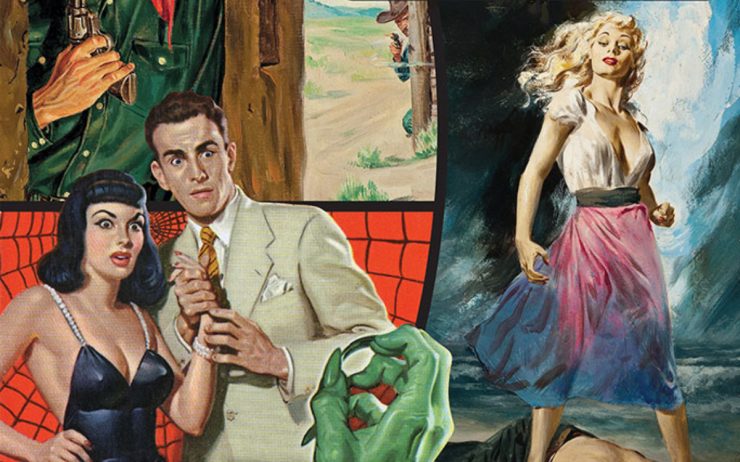Pulp magazines have influenced writers, artists, film directors, software developers, and countless others over the years. Our “PulpFest Profiles” focus on contemporary creators who have drawn inspiration from these rough-paper fiction magazines.
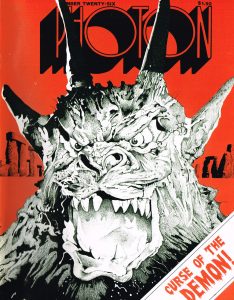 William Patrick Maynard (WPM): Ed Hulse has been a mainstay of film and pulp fandom for decades. A tireless champion of rare silent and Golden Age films and serials, Ed has been a pop culture renaissance man.
William Patrick Maynard (WPM): Ed Hulse has been a mainstay of film and pulp fandom for decades. A tireless champion of rare silent and Golden Age films and serials, Ed has been a pop culture renaissance man.
Ed, tell us how it all began for you: from childhood passions to involvement with film and pulp fandom.
Ed Hulse: Unlike the kids I grew up with, I was a lousy athlete, and watching sports on TV bored me. My chief interests were serials, mystery and horror films, comic books, and escapist fiction of all types. I always gravitated to “vintage” material — stuff from the ‘30s and ‘40s. In the early ‘60s, as a big fan of Tarzan movies, I read the Ballantine reprints of Edgar Rice Burroughs’ novels as fast as they appeared. I bought Bantam’s first Doc Savage reprint the week it hit the shelves. A couple of years later, I was the first kid in the neighborhood to buy Lancer’s Conan reprints with those great Frank Frazetta covers. I was buying Ace and Pyramid reprints of classic SF stories originally published in pulps. I was a pulp fan long before ever laying eyes on one of the old magazines.
I was always a voracious reader. So writing came easy to me and was one of the few things I seemed to be good at. I began contributing to a horror-movie fanzine called PHOTON when I was 13. Fanzines fascinated me, and when I was 14 my parents bought me a used mimeograph — one of those old hand-cranked jobs. I published a zine called FANTASY WORLD, which made a less than stellar debut in 1967. Contributing to various zines (most of them covering SF and horror films) made my name recognizable to other fans, some of whom I met at NyCon III, the 25th World Science Fiction Convention, held in 1967. That experience profoundly affected me and I became an enthusiastic convention-goer.
WPM: You’ve been a journalist for respected publications such as THE NEW YORK TIMES, THE WASHINGTON POST, THE NEW YORKER, VARIETY, PLAYBOY, and ENTERTAINMENT WEEKLY. How did you start your professional writing career?
Ed Hulse: In early 1980, I was between jobs and scrambling to find work. My long-time friend and fellow film and pulp enthusiast, Mark Trost, had recently begun writing freelance for a New York-based company that published trade journals covering the consumer electronics industry. Its first newsstand magazine was VIDEO REVIEW. The editor built a stable of critics drawn from the ranks of local movie buffs with encyclopedic knowledge. I qualified and was enlisted to write a chunk of the 500 capsule reviews needed every month. My stuff proved popular and before long I was being assigned feature articles. Eventually, I was writing for the likes of AUDIO TIMES, CONSUMER ELECTRONICS MONTHLY, and HOME SATELLITE MARKETING where I became Senior Editor.
In 1986, my publisher started PREVIEWS. I was the editor-in-chief and spent four very happy years in that position. During that time, some of my work was syndicated to newspapers all across the country by the WASHINGTON POST Writers’ Group. Eventually, I secured assignments from more prestigious publications on a freelance basis.
WPM: How did you come to start Murania Press and your award-winning BLOOD ‘N’ THUNDER magazine?
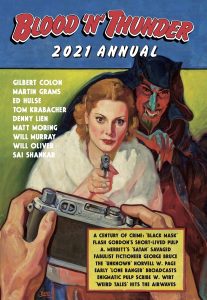 Ed Hulse: When I began attending Pulpcon in 1995, I scarfed up such fanzines as ECHOES, PULP VAULT, and PURPLE PROSE. They all impressed me, and with printer’s ink already coursing through my veins, it wasn’t long before I started telling Mark Trost that we ought to publish our own ‘zine. The ready availability of desktop-publishing software strengthened my resolve. I came up with a title and a boyhood chum designed the logo. BLOOD ‘N’ THUNDER started in 2002 and covered pulps, dime novels, vintage movies, Old Time Radio, even comic books and strips. We printed 300 copies and debuted at that year’s Pulpcon. To our surprise, it was warmly received. We never expected to sell all 300 copies, but in a couple of months, they were gone. I found a local printer and we went into a second printing.
Ed Hulse: When I began attending Pulpcon in 1995, I scarfed up such fanzines as ECHOES, PULP VAULT, and PURPLE PROSE. They all impressed me, and with printer’s ink already coursing through my veins, it wasn’t long before I started telling Mark Trost that we ought to publish our own ‘zine. The ready availability of desktop-publishing software strengthened my resolve. I came up with a title and a boyhood chum designed the logo. BLOOD ‘N’ THUNDER started in 2002 and covered pulps, dime novels, vintage movies, Old Time Radio, even comic books and strips. We printed 300 copies and debuted at that year’s Pulpcon. To our surprise, it was warmly received. We never expected to sell all 300 copies, but in a couple of months, they were gone. I found a local printer and we went into a second printing.
PLAYBOY‘s Hugh Hefner began subscribing with the second issue, and I publicized that fact wherever I could. With #3 we acquired Bud’s Art Books as our first large wholesale account. Their standing order was 150 copies, forcing us to go into second printings on several of the first ten issues. We found ourselves selling a minimum of 500 copies per issue, originally on a quarterly schedule.
Initially, Mark Trost handled the business aspects while I confined myself to editorial chores. But after two or three years, I became a one-man-band. In 2009, I persuaded fellow Gotham Pulp Collector Club member Chris Kalb to help me. He completely redesigned the ‘zine, which I began publishing via CreateSpace.
WPM: While publishing BLOOD ‘N’ THUNDER, you also began writing and publishing books through Murania Press such as THE BLOOD ‘N’ THUNDER GUIDE TO PULP FICTION, FLICKERING SHADOWS, the two-volume CLIFFHANGER CLASSICS, THOSE SEXY SERIAL QUEENS, and many others. Tell us how projects like these developed as well as the two-volume THE BEST OF BLOOD ‘N’ THUNDER. Will there be further volumes?
Ed Hulse: THE BLOOD ‘N’ THUNDER GUIDE TO COLLECTING PULPS was strictly intended to give the brand additional credibility. It was quite an undertaking. I began writing it in 2006 and published it the following year. That was actually the first publication of Murania Press (“Murania” being the underground kingdom in the 1935 Gene Autry serial, THE PHANTOM EMPIRE). The book’s success inspired me to revise and expand it in 2014 as THE BLOOD ‘N’ THUNDER GUIDE TO PULP FICTION. To broaden the second edition’s appeal, I slightly deemphasized the collecting angle to make it more of a reference book. It remains the bestselling title in the Murania catalog, and, to my great satisfaction, has been adopted as a text in pop-culture or popular-literature courses taught at six U.S. universities.
 My two-volume history of silent-era movie serials, DISTRESSED DAMSELS AND MASKED MARAUDERS and HANDSOME HEROES AND VICIOUS VILLAINS, was the product of intensive research conducted over a quarter-century. The two BEST OF BLOOD ‘N’ THUNDER volumes and such books as FIGHTING CRIME ONE DIME AT A TIME allowed me to repackage material first published in the ‘zine. With the first 21 issues of BLOOD ‘N’ THUNDER long out of print, I needed vehicles to keep many of the articles in print. Will there be more? Stay tuned.
My two-volume history of silent-era movie serials, DISTRESSED DAMSELS AND MASKED MARAUDERS and HANDSOME HEROES AND VICIOUS VILLAINS, was the product of intensive research conducted over a quarter-century. The two BEST OF BLOOD ‘N’ THUNDER volumes and such books as FIGHTING CRIME ONE DIME AT A TIME allowed me to repackage material first published in the ‘zine. With the first 21 issues of BLOOD ‘N’ THUNDER long out of print, I needed vehicles to keep many of the articles in print. Will there be more? Stay tuned.
WPM: Murania Press has also published the attractive and affordable reprint series, FORGOTTEN CLASSICS OF PULP FICTION. It quickly carved a niche for itself in the marketplace alongside Altus Press/Steeger Books and similar publishers. Tell us about your decision to reprint fiction titles and your plans for the line.
Ed Hulse: The FORGOTTEN CLASSICS series was born as a result of my voluminous reading of such classic pulps as ADVENTURE, ARGOSY, BLUE BOOK, THE POPULAR MAGAZINE, and SHORT STORIES. While putting together surveys of these magazines for BLOOD ‘N’ THUNDER, I discovered — or rediscovered, to be more precise — many terrific yet forgotten novels that were long out of print. I came up with ten that I’d want in my own library.
I’m committed to the FORGOTTEN CLASSICS concept and am working on another group of ten novels from the 1910s and early 1920s. Fortunately, print-on-demand frees the small-press publisher from the crushing burden of printing a thousand copies to get a decent unit cost. I’m willing to do the editorial and layout work necessary, even if only to have those particular books in my own library.
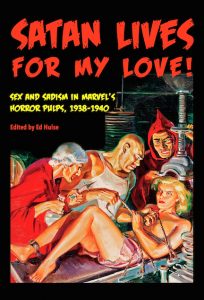 For the record, my best-selling volume of pulp reprints is SATAN LIVES FOR MY LOVE, an anthology of sex-and-sadism weird menace stories originally published in the Red Circle pulps of Marvel Comics founder Martin Goodman.
For the record, my best-selling volume of pulp reprints is SATAN LIVES FOR MY LOVE, an anthology of sex-and-sadism weird menace stories originally published in the Red Circle pulps of Marvel Comics founder Martin Goodman.
WPM: One of your most celebrated works was co-editing THE ART OF THE PULPS with Doug Ellis and the late Robert Weinberg. Tell us how that project came about, your involvement, and its reception.
Ed Hulse: Sadly, I got involved when Bob Weinberg — who had developed the concept with Doug — passed away, just a few days before signing the contract with our British packager, Elephant Book Company. Doug believed I could fill Bob’s very big shoes. He asked me if I was available, and I was happy to sign on.
The book still maintains an overall five-star rating with nearly 120 reviews posted on Amazon. It was a pleasure to collaborate on an elaborate project with such old friends as Doug, Will Murray, Michelle Nolan, Laurie Powers, Tom Roberts, David Saunders, and John Wooley.
WPM: Your latest project for IDW is the companion volume, THE ART OF PULP FICTION. Tell us about the book, how it came about, and why both volumes are essential.
Ed Hulse: To be clear, IDW is the American publisher. They agreed to distribute THE ART OF THE PULPS after it was pitched to them by Elephant Book Company. Doug and I did it as a work-for-hire. Since it was so well received, Elephant contemplated a follow-up. The second book would do for paperbacks what the first did for pulps.
I persuaded PAPERBACK PARADE publisher Gary Lovisi to collaborate with me, but prior commitments forced him to drop out. I asked Elephant’s project manager if he had any objection to me doing the book solo. To my surprise, he didn’t and I signed the contract in January 2020. After that, it was reading anything I could find about vintage paperbacks, scanning and Photoshopping nearly 600 paperback covers, and writing the copy, including some 450 captions at fifty words each.
Working with Elephant’s staff on editing and design consumed another few months, and we finally had a completed book by the end of March. It went to China for printing, was shipped here by boat, and reached our shores in mid-August. The official publication date is September 28, but I’ll be displaying an advance copy at Windy City and taking orders for signed copies, which I’ll be selling through my Murania Press website.
WPM: Ed, you have distinguished yourself in multiple fields with your knowledge and professionalism as a pop culture scholar and historian. You remain a welcoming presence in fandom for newcomers and old friends alike. You embody the spirit of fandom at its best. This has been a true pleasure. Thank you, most sincerely.
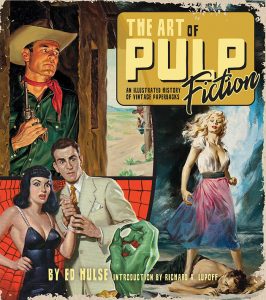 Ed Hulse’s THE ART OF PULP FICTION: AN ILLUSTRATED HISTORY OF VINTAGE PAPERBACKS chronicles the history of pocket-sized paperbound books designed for mass-market consumption, specifically concentrating on the period from 1940 to 1970. Today early paperbacks — inexpensively produced and considered disposable by casual readers — are treasured collector’s items.
Ed Hulse’s THE ART OF PULP FICTION: AN ILLUSTRATED HISTORY OF VINTAGE PAPERBACKS chronicles the history of pocket-sized paperbound books designed for mass-market consumption, specifically concentrating on the period from 1940 to 1970. Today early paperbacks — inexpensively produced and considered disposable by casual readers — are treasured collector’s items.
Ed began contributing to the horror-movie fanzine PHOTON when he was 13-years-old. Pictured at the start of our post is issue #26, published in 1975 by Mark Frank.
During the early years of Ed’s BLOOD ‘N’ THUNDER, it was a quarterly. These days, it’s published annually. Pictured above is the 2021 issue, featuring cover art by Rudolph Belarski. The art originally adorned the April 8, 1939 issue of DETECTIVE FICTION WEEKLY.
The first volume of CLIFFHANGER CLASSICS reprints twenty essays culled from the pages of BLOOD ‘N’ THUNDER. The cover design is by Age of Aces co-publisher, Chris Kalb. The second volume of essays followed five years after the first.
The best-selling SATAN LIVES FOR MY LOVE features cover art by J. W. Scott. It was originally done for the May 1939 issue of Western Fiction Publishing’s MYSTERY TALES. Scott was a freelance artist who sold to a variety of magazines, including Martin Goodman’s infamous weird menace pulps.
William Patrick Maynard is the licensed continuation author for the Sax Rohmer Literary Estate. His short fiction has been published in anthologies by Airship 27, Bold Venture Press, Black Coat Press, Edge Publishing, Flinch Books, MX Books, Riviere Blanche, and Titan Books. He has authored over 250 articles for numerous magazines and websites. He has contributed Blu-ray commentary tracks and produced bonus features for releases by MGM, Shout Factory, Kino Lorber, and The Serial Squadron. Bill is on the editorial board of The Battered Silicon Dispatch Box and is a member of the PulpFest Organizing Committee where he serves as Assistant Director of Marketing and Afternoon Programming Director. He resides in Northeast Ohio.

